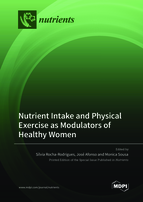Nutrient Intake and Physical Exercise as Modulators of Healthy Women
A special issue of Nutrients (ISSN 2072-6643). This special issue belongs to the section "Nutrition in Women".
Deadline for manuscript submissions: closed (20 August 2021) | Viewed by 62357
Special Issue Editors
2. Tumor & Microenvironment Interactions Group, i3S, 4200-135 Porto, Portugal
Interests: exercise physiology; obesity-related disorders; breast cancer; hormones
Special Issues, Collections and Topics in MDPI journals
Interests: training theory and methodology; exercise prescription; performance analysis; strength and conditioning
Special Issues, Collections and Topics in MDPI journals
Special Issue Information
Dear Colleagues,
Cumulative evidence demonstrates that healthy nutrient intake and regular physical exercise are both powerful lifestyle strategies that modulate lifelong health through their ability to improve body composition, musculoskeletal health, sex steroid hormones, sleep quality, and physical and cognitive performance, as well as to prevent chronic diseases across the lifespan, especially in women. While the benefits of nutrition and physical exercise are commonly studied separately, the integration of nutrition and physical exercise has the potential to produce greater benefits in women than strategies focusing only on one or the other. Studying the specificities of women in response to interventions is of the utmost importance for providing optimal healthcare and aids the design of guidelines that are better suited for women. A better knowledge regarding nutrient intake and physical exercise and their interaction in women is therefore needed. This Special Issue entitled “nutrient intake and physical exercise as modulators of healthy women” will comprise manuscripts that highlight this integrational approach as a potential modulator of lifelong outcomes in women.
Dr. Sílvia Rocha-RodriguesGuest Editor
Dr. José Afonso
Dr. Monica Sousa
Co-Guest Editors
Manuscript Submission Information
Manuscripts should be submitted online at www.mdpi.com by registering and logging in to this website. Once you are registered, click here to go to the submission form. Manuscripts can be submitted until the deadline. All submissions that pass pre-check are peer-reviewed. Accepted papers will be published continuously in the journal (as soon as accepted) and will be listed together on the special issue website. Research articles, review articles as well as short communications are invited. For planned papers, a title and short abstract (about 100 words) can be sent to the Editorial Office for announcement on this website.
Submitted manuscripts should not have been published previously, nor be under consideration for publication elsewhere (except conference proceedings papers). All manuscripts are thoroughly refereed through a single-blind peer-review process. A guide for authors and other relevant information for submission of manuscripts is available on the Instructions for Authors page. Nutrients is an international peer-reviewed open access semimonthly journal published by MDPI.
Please visit the Instructions for Authors page before submitting a manuscript. The Article Processing Charge (APC) for publication in this open access journal is 2900 CHF (Swiss Francs). Submitted papers should be well formatted and use good English. Authors may use MDPI's English editing service prior to publication or during author revisions.
Keywords
- nutrition
- physical activity
- lifespan
- healthy lifestyles
- women-driven guidelines









